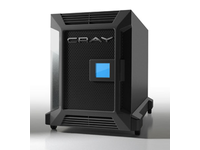Cray Unveils Its Smallest Super PC Ever
Cray releases its smallest supercomputer ever and it comes loaded with Windows.

If you have ever dreamed of having your own supercomputer before, it looks like now is your chance. Cray, the supercomputer company, has just released its smallest supercomputer ever and with a price tag to match. While still not exactly cheap, the new Cray CX1 can be configured to be relatively consumer affordable, priced at about the cost of a new Kia sedan. Such a stripped-down configuration though will only buy a basic system featuring a pair of Intel Xeon processors and one very nice system enclosure. Considering that the enclosure alone costs about $9,000, a truly realistic configuration would probably start closer to $25,000 and then quickly go up from there.
The Cray CX1 is available in several customizable configurations from Cray.com, with a beautiful chassis that has eight slots available for nodes. The system can be configured with several differently themed nodes to suit different system requirements, such as processing, storage and visualization. Depending on the system configuration, there is enough room for up to 16 Intel Xeon quad-core processors, dozens of hard disk drives and enough RAM to shake a proverbial stick at. Although the Cray CX1 may still pale in comparison to other supercomputers in pure performance, it does have a few things going for it, not the least being its portability factor.
While the Cray CX1 is available with Red Hat Linux installed, it is also available with Microsoft Windows HPC Server 2008. Windows HPC Server 2008 has been designed to efficiently scale to thousands of processing cores while still addressing the needs of users who require an easy way to simplify the supercomputer environment. According to Microsoft’s Vince Mendillo, "Windows HPC Server 2008, in combination with the Cray CX1 supercomputer, will provide outstanding sustained performance on applications. This combined solution will enable companies in various sectors to unify their Windows desktop and server workflows. Many Microsoft financial services customers, for example, want to unify back-office modeling and simulation with the work of front-office trading desks.”
So if you have over $9,000 lying around, toss those bills in and nab yourself one of these babies.
Stay on the Cutting Edge
Join the experts who read Tom's Hardware for the inside track on enthusiast PC tech news — and have for over 25 years. We'll send breaking news and in-depth reviews of CPUs, GPUs, AI, maker hardware and more straight to your inbox.
-
magicandy mtyermomYou would have preferred phenoms?Reply
I think he was referring to the fact that this is just a glorified workstation rather than an actual supercomputer with highly customized CPUs. And just two of them for $9000? Hell, even a Skulltrail could probably destroy this at thousands less. -
Shadow703793 ^Correct.Reply
When Nehalem comes out that should shake things up in the HPC market. Also for any high intense calculations (only some kinds of calculations) one can also use a GPU based solution if possible, which is much cheaper than any CPU solution. -
doomturkey Uh guys... Read the article.Reply
"Considering that the enclosure alone costs about $9,000..."
The enclosure is $9k. Not the computer. That's expensive as fuck.
Most Popular



